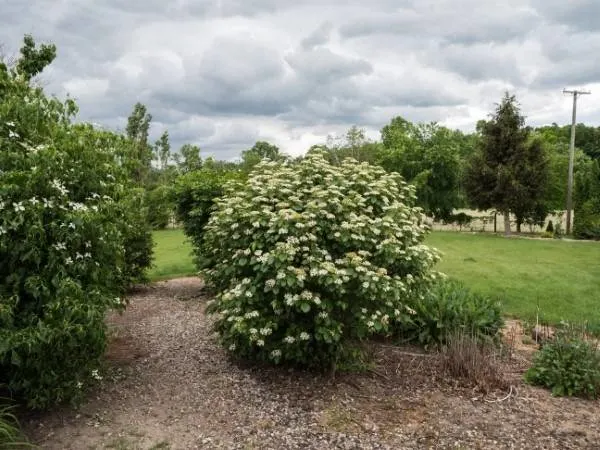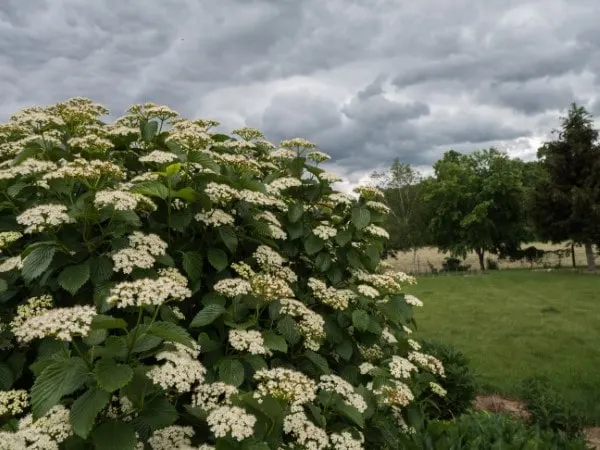Autumn Jazz Viburnum plant is among the most beautiful ornamental plants you will ever set your eyes on. Native to south America, southeast Asia, Russia, and Ukraine, they are surely not among your regular crowd of house plants because of their stunning, scalloped leaves with wonderful clusters of flowers that give off really pleasant fragrances and bear tiny fruits.
This plant will be an excellent addition to your collection of house plants if you wish to give your home garden a simple yet elegant appearance.

The main characteristics of an Autumn Jazz Viburnum
Growth rate
Overall, the Autumn Jazz Viburnum is considered to be a pretty fast grower. All you need to do to get this plant to grow out really fast is to provide it with the optimal growing conditions we’ve laid down below.
When these conditions are met, this plant will grow about 13 to 14 inches in length every year. At maturity, this plant will be about 2 feet in width and height.
Top 6 crucial caring tips for your Autumn Jazz Viburnum
Lighting Needs
Autumn Jazz Viburnum plants prefer bathing under direct sunlight – for optimal growth, keep your plant exposed to the direct sun at least 7 hours a day.
If the sun is burning hot, make sure you water your plant well to ensure that it doesn’t burn under the heat of the sun. To save yourself the trouble, though, you can also keep your plant under a shade where it will receive bright, but indirect sunlight.
Soil Needs
This shrubs likes soil that is moderately wet but well-draining, and they don’t tolerate having their roots soaked in water. Viburnums like somewhat acidic soil, although many varieties will grow in alkaline soil as well.
Watering Needs
For optimal growth, water your Autumn Jazz Viburnum deeply every 7 to 10 days. If you notice dry soil between this waiting interval, feel free to water your plant again, but make sure that the soil doesn’t get waterlogged.
Temperature Needs
The Autumn Jazz Viburnum is pretty flexible and well adapted to a decent spread of temperature ranges. So, in most cases, you won’t need to do anything to ensure that your plant is receiving its optimal growing temperature. In cases of extreme heat, though, you’re advised to water your plant a bit more than usual
Humidity Needs
The Autumn Jazz Viburnum generally prefers humid environments. For optimal growth, ensure that you keep your plant’s surrounding humidity levels above 85%.
Whatever you do, make sure that the humidity levels don’t fall below 40%. If you live in a relatively dry region, we strongly advise that you invest in a humidifier.
Fertilizers
Fertilizers can go a long way in helping your Autumn Jazz Viburnum establish itself. For best results, fertilize your plant at least once a year especially during spring season.

How to successfully propagate an Autumn Jazz Viburnum indoors
When it comes to propagating an Autumn Jazz Viburnum, the most important thing you need to be mindful of is timing. There are 2 ways you can propagate your Autumn Jazz Viburnum; the first is through softwood cuttings, and the second is through hardwood cuttings.
The general consensus prefers the softwood cuttings method over the hardwood cutting method since the latter is known to be more difficult to root.
If you choose to propagate your plant using the hardwood cutting mehtod, though, you should probably wait till fall season to begin the procedure to achieve the best results. This, however, is no fixed rule, for many gardeners have also been able to successfully propagate this plant during winters.
If you’re a newbie in the gardening arena, though, you should wait till springtime before you propagate this plant using either of the two propagation methods we will discuss below.
Propagating an Autumn Jazz Viburnum using softwood cuttings
Here is the procedure:
- The first thing you need to do, even before you begin this process, is to sterilize your equipment.
- Once you’ve done so, take out some softwood cuttings from an existing Autumn Jazz Viburnum plant.
- These cuttings must be healthy and at least 4 to 6 inches in length (roughly 10 to 15 centimeters).
- Now, take your cuttings and remove all of the leaves attached to the lower section of your cutting. Additionally, you should also remove any dead leaves from your cuttings, so your new plant remains in good health.
- After this, mix equal parts of peat and perlite into your standard potting mix and water your soil just enough that it becomes moist.
- At this point, (this is an optional step) you are encouraged to dip your softwood cuttings into a rooting hormone to speed up the rooting process.
- Now, bury the lower end (the cut end) of your cuttings into the soil mix you’ve prepared.
- If you want your plant to retain humidity better, cover your pot with a plastic sheet so the moisture remains trapped. This will help optimize your new plant’s growing conditions.
- The rooting time period will vary from plant to plant, but usually, you should be able to observe rooting within 4 weeks.
- After your plant has properly established its roots, relocate it to a larger pot where it can permanently remain.
Propagating an Autumn Jazz Viburnum using hardwood cuttings
As we mentioned earlier, this method will be a bit more difficult and time consuming. Still, as promised, here are the steps you need to follow:
- Start by sterilizing your equipment, and then taking out a hardwood cutting from an existing Autumn Jazz Viburnum plant.
- This cutting should be about 8 to 10 inches in length (roughly 20 to 26 centimeters) and must host several leaf nodes.
- Now, remove all leaves attached to the lower end of your cutting and then dip your cutting into a rooting hormone. In the hardwood cutting method, the use of rooting hormones is strongly advised. This is because it is much more difficult for rooting to occur using this method.
- Now, mix your standard potting soil with 2 parts peat moss and 3 parts perlite and ground the lower end of your cutting into this mix.
- You will have to wait for several weeks to observe rooting.
- Once the roots have developed, move your plant to a permanent location.
Summary
All in all, the Autumn Jazz Viburnum will make for a pretty good addition to your collection of houseplants. To ensure that your plant grows healthy follow these caring tips:
- Water your plant once a week.
- Expose your plant to the full sun.
- Ensure high levels of humidity and keep your plant at room temperature.
- Fertilize it annually during spring season.
- Keep it in a well-draining soil mix
Use the softwood or hardwood cutting method to propagate your plant successfully indoors. We recommend you use the softwood cutting method since it roots much faster.
